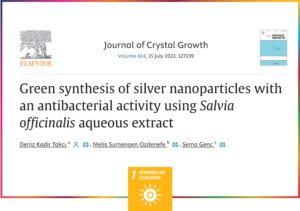
Researchers from Near East University have collaborated on a study, presenting a rapid and eco-friendly method for the green biosynthesis of silver nanoparticles (AgNPs) using Salvia officinalis aqueous extract. The transformation of silver ions to AgNPs was visually evident through a distinct color change from colorless/yellow to reddish-brown during the process, indicating the phytosynthesis of AgNPs.
The Salvia officinalis leaf extract served a dual role, acting as both a reducing and capping agent for the formation of AgNPs. This dual functionality was confirmed through Fourier-transform infrared spectroscopy (FTIR), which identified the presence of functional groups in the plant extract. The AgNPs were characterized using various techniques, including ultraviolet–visible spectroscopy, X-ray diffraction (XRD), scanning electron microscopy (SEM), and energy-dispersive X-ray analysis (EDX).
The UV–Visible spectrum exhibited a characteristic absorption peak for Ag at around 457 nm, with optical bandgaps of approximately 2.22 eV. XRD patterns revealed a face-centered cubic silver nanostructure, with an average crystal size of approximately 20 nm, highlighting the efficiency of the synthesis process. Notably, the spherical AgNPs with an average size of 20 nm exhibited potent antibacterial activity against various pathogens, including Salmonella typhimurium, Pseudomonas aeruginosa, Staphylococcus aureus, and Escherichia coli.
This green synthesis protocol stands out for its efficiency, requiring only 15 minutes for the conversion of silver ions into AgNPs through heating. The method is not only rapid but also simple, sustainable, cost-effective, and energy-efficient, presenting a promising alternative to conventional chemical/physical synthesis methods.
In relation to Sustainable Development Goal 7 (SDG 7), which focuses on ensuring access to affordable, reliable, sustainable, and modern energy for all, this research aligns with the goal by emphasizing an energy-efficient and environmentally benign approach to nanoparticle synthesis. The cost-effective and non-toxic nature of the Salvia officinalis-based method opens avenues for diverse applications in biosensors, biomedicine, water treatment, and nanotechnology. This study encourages researchers to explore novel approaches for the biosynthesis of AgNPs, showcasing their antibacterial properties and contributing to the advancement of sustainable technologies.
More Information:
https://www.sciencedirect.com/science/article/pii/S0022024823001653